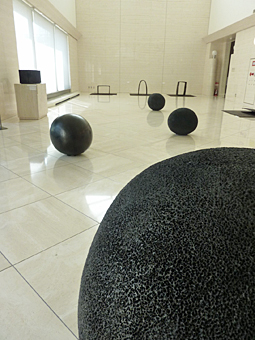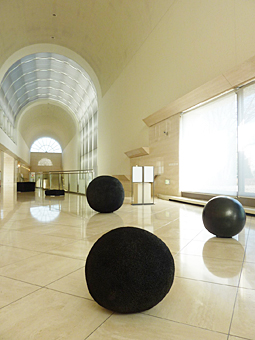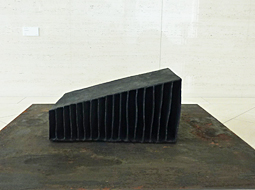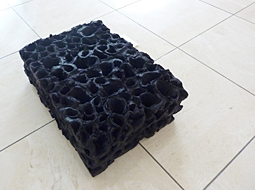 |
|
 |
Jet-black spheres of varying sizes seem casually rolled into place in the public lobby of the Hiratsuka Museum of Art.
|
|
Higuchi's custom technique of scorching sumi-infused clay evokes the blackness of carbon. One sphere is given a burnished shine in contrast to others that are pocked like lava.
|
The extensive, travertine-clad Hiratsuka Museum of Art is an unexpected treasure to be found in the bedroom community of Hiratsuka. Located on the Shonan coast about an hour's train ride south of Tokyo and a twenty-minute walk from JR Hiratsuka station, the museum makes a nice lunch stop on the way from Tokyo to Izu. Currently on display in the long central lobby is Mono-Kuro (Black Things), an exhibition introducing the distinctive work of sculpture artist Takehiko Higuchi.
Born in Fukuoka in 1966, Higuchi now works out of his studio in Kamakura, just up the coast from Hiratsuka. He graduated from Osaka University of Art with a focus on ceramics and continued pursuing that discipline at Tama Art University. Higuchi has participated in artist-in-residence programs domestically and abroad. Some of his large-scale works can be found in public and private collections in Japan and overseas in Singapore, Argentina and the United States. He is seen as an emerging artist who is exploring new techniques in ceramic sculpture.
Higuchi's first solo exhibition, Mono-Kuro showcases 18 works including a number of new pieces. The collection is illuminated only by the barrel-vaulted skylights of the grand upper lobby. The viewer may be forgiven for misconstruing these matte-black geometric objects as made of iron or lava rock. In fact, Higuchi's work is produced by infusing clay with sumi ink and then scorching the pieces with a burner; the result is a dramatic finish devoid of all trace of light.
 |
|
 |
The ceramic plates assembled together appear as delicate as a piece of mille feuille.
|
|
Higuchi's earthy collection is illuminated only by the barrel-vaulted skylights above the Hiratsuka Museum of Art lobby. |
Higuchi loosely categorizes his work into three themes that have been evolving concurrently since 2005: geometric volumes, planar pieces, and large black spheres. Ranging in size from about 50 to 100 centimeters in diameter, the four large spheres on display seem casually rolled into place. While they are all deep sumi-black, three of the spheres are covered in small pockmarks, giving them a lava-like finish, whereas the fourth is burnished with a sheen resembling that of a giant cannonball. Because they are not displayed on platforms, the spheres appear to hover over the museum's stone floor. The light-filled gallery space provides an elegant contrast to Higuchi's rough-textured ensemble.
On the periphery are works classified as either geometric volumes or planar pieces. These, too, fool the eye as they seem more likely to be the work of a metalsmith. The planar extrusions and cut sections in U or O shapes seem almost two-dimensional compared to the spheres. The geometric volumes are formed by assembling hundreds of thin ceramic plates together; the result is as delicate as a piece of mille feuille. Higuchi clearly enjoys exploiting the many possibilities of his signature technique.
The pieces in Mono-Kuro do not appear to be conceptually driven, but rather, uniquely process-driven. They are all dated but untitled. This suggests that Higuchi does not have a specific vision of the outcome: refining his technique is the artistic objective. It is through such explorations that he demonstrates the inexhaustible possibilities of a limited palette.
 |
|
 |
| A filter-like piece from the "thin ceramic plate" series. |
|
Close-up of an unnamed piece from Higuchi's geometric shapes series.
All photos taken by Nicolai Kruger with the permission of the Hiratsuka Museum of Art |
|